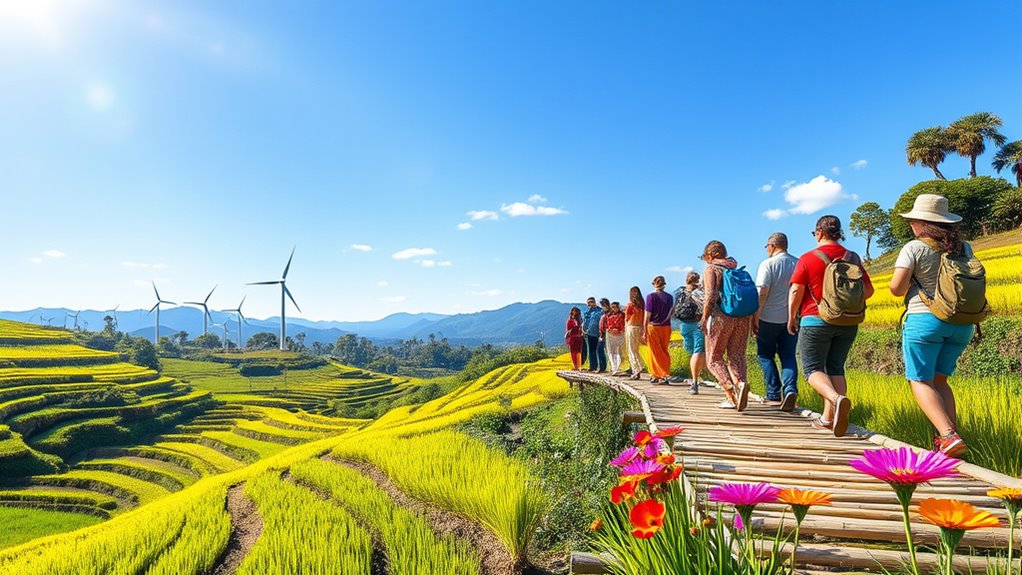World Tourism Day 2025 celebrates sustainable travel by highlighting innovative ways to protect destinations, support local communities, and reduce environmental impacts. You’ll see efforts like eco-friendly accommodations, renewable energy use, and responsible tourism practices gaining momentum. Organizations are promoting policies and technologies that make travel more eco-conscious and inclusive. If you want to discover how you can contribute to this global movement and enjoy meaningful travel, there’s more to explore below.
Key Takeaways
- World Tourism Day 2025 focuses on transforming knowledge into actions to promote sustainable travel practices.
- Emphasizes eco-friendly infrastructure, renewable energy, and circular economy principles to protect destinations and communities.
- Highlights responsible tourism’s economic and social benefits, including community engagement and cultural preservation.
- Promotes innovative technologies like AI and green transportation to reduce environmental impacts.
- Supports global initiatives and policies aimed at ensuring sustainable, inclusive, and responsible tourism development.
The Origins and Significance of World Tourism Day
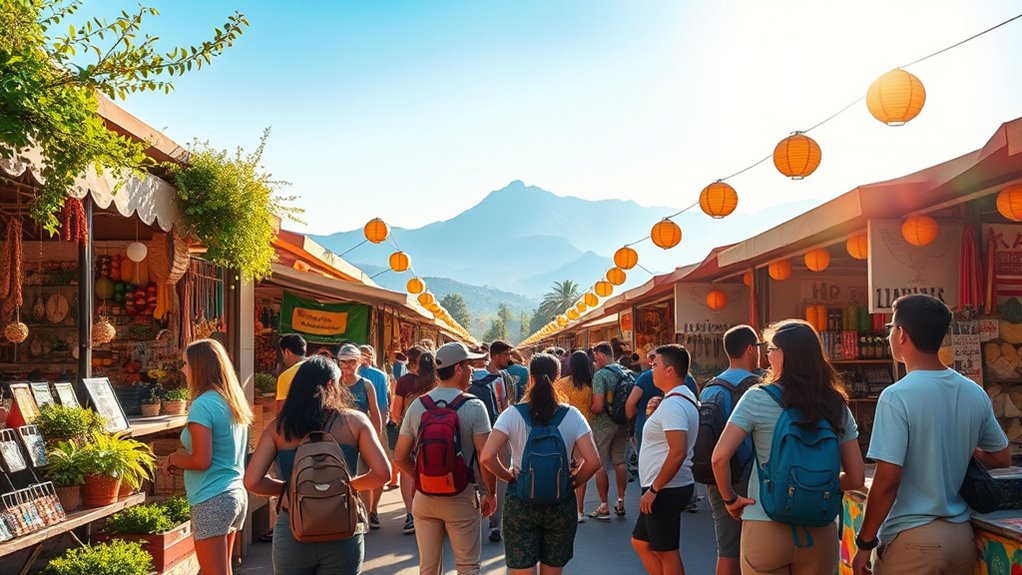
World Tourism Day was established in 1979 during the UNWTO’s third General Assembly in Torremolinos, Spain, to promote responsible and sustainable tourism worldwide. This day marks an important chapter in tourism history, highlighting how travel has evolved over centuries. From ancient times, when kings in China built infrastructure for travelers, to the religious pilgrimages of the Middle Ages, tourism has transformed from an exclusive activity for the wealthy into a global economic force. The UNWTO’s creation in 1970 helped formalize tourism’s growth, emphasizing ethical practices and sustainable development. Celebrated annually on September 27, World Tourism Day underscores the importance of tourism’s social, cultural, and economic contributions. It reminds us how travel has shaped civilizations and continues to foster understanding and inclusive growth worldwide. Tourism is expected to grow 3% annually until 2030, driven by rising middle classes and cheaper transport, ensuring its ongoing significance in global development. Additionally, increased awareness of environmental impact has encouraged more sustainable travel practices to preserve destinations for future generations.
The 2025 Focus: Promoting Sustainable Transformation in Tourism
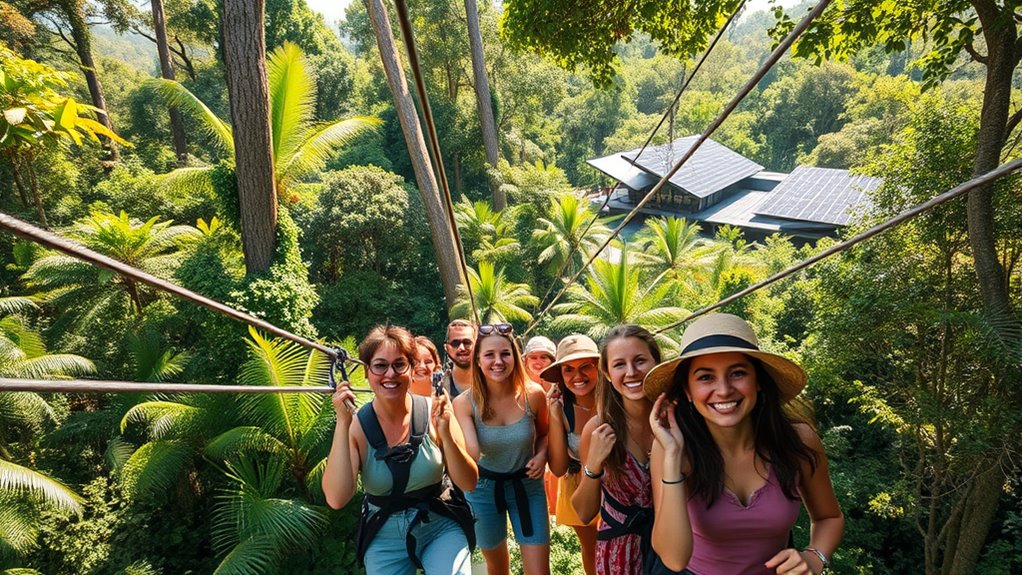
Building on the significance of World Tourism Day’s history, the focus for 2025 centers on promoting sustainable transformation within the tourism sector. This year, the emphasis is on turning knowledge into impactful actions that protect destinations and communities. To achieve this, you should support initiatives like:
Promote sustainable tourism by turning knowledge into actions that protect destinations and empower communities.
- Implementing eco friendly packaging to reduce waste.
- Participating in carbon offset programs to lower your travel footprint.
- Investing in sustainable infrastructure that minimizes environmental impact.
- Promoting circular economy principles to optimize resource use.
These strategies help ensure tourism’s economic and social benefits are preserved without degrading the environment. By embracing sustainable practices, you contribute to climate response efforts and socio-economic resilience, fostering a future where travel benefits both people and the planet. Sustainable transformation is essential for creating resilient tourism systems that can adapt to changing environmental and social challenges. Engaging with eco-friendly innovations can further enhance the positive impact of sustainable tourism initiatives.
Economic Benefits and Social Impact of Responsible Travel
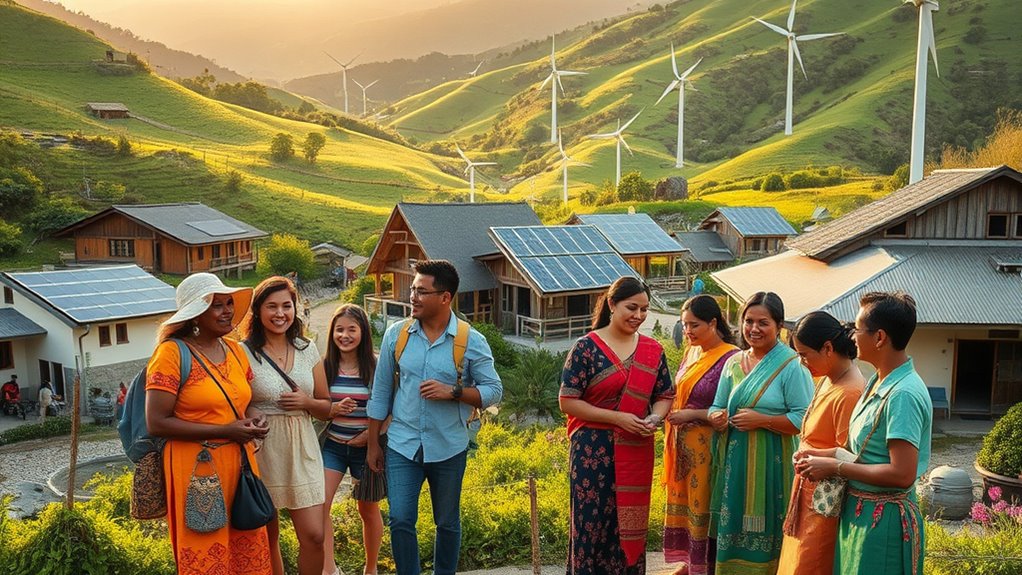
Responsible travel drives significant economic growth and social progress by creating jobs, boosting local economies, and promoting community well-being. Eco tourism development plays a key role, generating billions in revenue and supporting millions of jobs worldwide. For example, nature-based tourism in protected areas like Bwindi Impenetrable National Park produces substantial economic benefits, far exceeding its park budget. This growth encourages investment in rural and underdeveloped regions, diversifying economies and increasing community income. Cultural exchange is central to responsible travel, fostering understanding and strengthening local identities. By integrating local traditions into tourism experiences, communities gain pride and cultural preservation. Additionally, responsible travel spreads economic benefits more evenly across regions, reducing overcrowding and supporting social stability. Digital transformation is also increasingly being utilized to enhance sustainable practices and improve visitor management, ensuring long-term benefits for host communities. Incorporating community engagement strategies further amplifies positive social impacts by involving local residents in planning and decision-making processes. Overall, responsible travel creates a sustainable, mutually beneficial relationship between visitors and host communities.
Addressing Environmental Challenges in the Tourism Industry

As tourism continues to grow, addressing its environmental challenges becomes essential for sustainable development. You can help by supporting eco-friendly transportation options, reducing your waste, and choosing sustainable accommodations. Here are key actions to contemplate:
- Opt for eco-friendly transportation like trains, bikes, or electric vehicles to lower carbon emissions. Aviation accounts for 52% of tourism’s direct carbon footprint.
- Minimize waste by carrying reusable items and avoiding single-use plastics.
- Support local initiatives that manage waste effectively and protect natural habitats.
- Be mindful of infrastructure development, avoiding sites that cause habitat destruction or pollution.
How Global Organizations Are Shaping Sustainable Tourism Initiatives
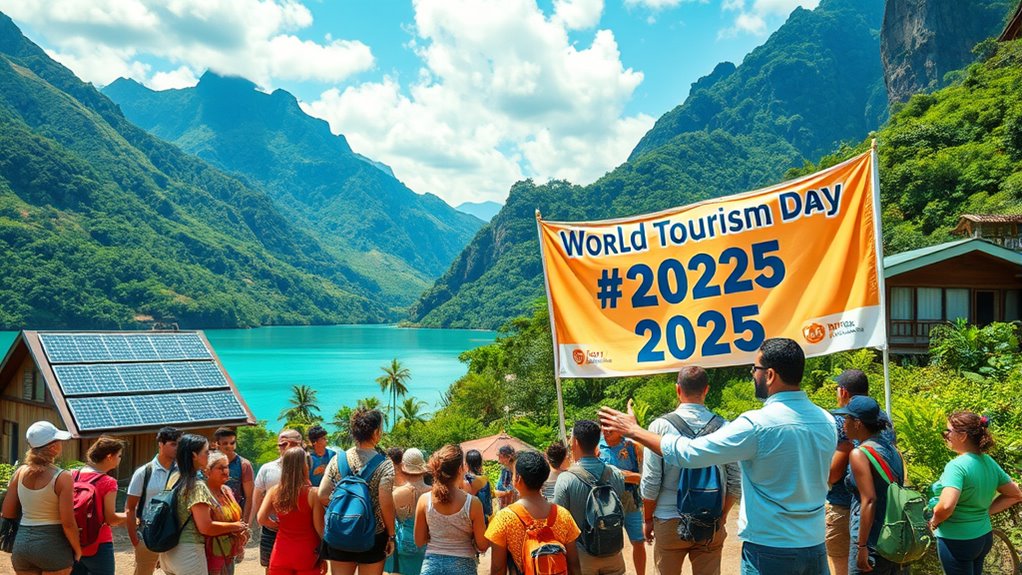
Global organizations play a pivotal role in shaping sustainable tourism initiatives worldwide. They set standards that promote wildlife conservation and cultural preservation, ensuring tourism benefits local communities and ecosystems. The United Nations Sustainable Development Goals guide efforts, particularly Goals 12 and 13, to promote responsible consumption and climate action. The Global Sustainable Tourism Council (GSTC) certifies hotels, operators, and destinations, helping them meet sustainability criteria that support biodiversity and cultural heritage. UNWTO fosters international cooperation, encouraging policies that protect natural and cultural assets. Initiatives like the One Planet Programme push for sustainable consumption, aligning industry practices with global climate and conservation goals. These organizations enhance industry accountability, attract eco-conscious travelers, and foster collaboration among governments, businesses, and civil society to promote responsible, sustainable tourism. Their efforts also include developing certification programs that help industry stakeholders demonstrate their commitment to sustainability. Additionally, leveraging AI-driven content analysis can aid in monitoring and improving industry compliance with sustainability standards.
Celebrating Host Countries and Their Contributions to Global Tourism
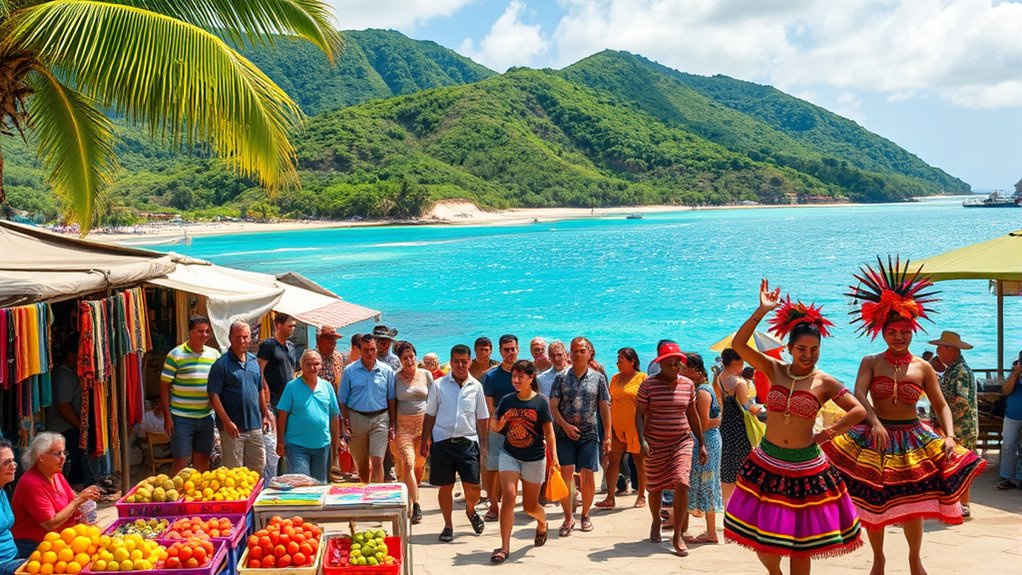
As a host country, you showcase your recognized cultural heritage sites and natural attractions to the world, highlighting what makes your region unique. You also introduce innovative tourism initiatives that promote sustainability and local traditions, demonstrating your commitment to responsible growth. These efforts not only attract visitors but also strengthen your country’s position as a leader in global tourism. Incorporating sustainable tourism practices can further enhance your reputation and ensure that your cultural and natural assets are preserved for future generations.
Recognized Cultural Heritage Sites
Recognized cultural heritage sites play an essential role in shaping the identity and appeal of their host countries, greatly boosting tourism and economic growth. These sites highlight the importance of cultural preservation and heritage management in maintaining their significance. The global distribution shows Europe leading with 473 cultural sites, reflecting long-term preservation efforts. Meanwhile, regions like Africa and the Arab States have fewer recognized sites, emphasizing the uneven global landscape. Specifically:
- Countries like Italy, China, and Spain host numerous UNESCO sites, attracting millions of visitors.
- Heritage management ensures sites are preserved while supporting tourism. Cultural preservation is fundamental to maintaining the authenticity and integrity of these sites for future generations.
- Nominations depend on national efforts and UNESCO’s criteria, influencing recognition.
- Heritage sites foster niche tourism, balancing economic benefits with conservation needs.
- The overall number of UNESCO World Heritage Sites worldwide continues to grow, with 26 new additions in 2025, reflecting ongoing efforts to recognize diverse cultural heritage.
These sites are crucial for cultural identity and sustainable tourism development worldwide.
Innovative Tourism Initiatives
Many host countries are pioneering innovative tourism initiatives that highlight their unique contributions and promote sustainable growth. Peru, for example, is developing eco lodge accommodations and green trekking paths to guide tourists sustainably through natural landscapes. Their focus on green transportation systems helps lower carbon emissions across tourist regions, aligning with their 2025 plans. Meanwhile, other countries invest in renewable energy, like solar-powered attractions in the Netherlands, Spain, and the U.S., reducing environmental footprints. Some transform old industrial sites into sustainable visitor attractions, such as Battersea Power Station in the UK. These efforts foster eco-friendly infrastructure, encouraging travelers to explore responsibly while supporting local economies. By embracing eco lodge development and green transportation, host countries demonstrate their commitment to preserving destinations for future generations. Incorporating sound design techniques can further enhance visitor experiences, making tourism more immersive and memorable.
Celebrated Local Traditions
Local traditions play an essential role in shaping authentic tourism experiences by showcasing the unique customs, festivals, and heritage of host countries. Celebrating local traditions allows you to connect deeply with a community’s identity through its traditional crafts, folk music, and rituals. These elements serve as tangible and intangible links to the past, enriching your cultural understanding. Here are some ways host countries contribute to global tourism:
- Highlighting traditional crafts that reflect local artistry and skills.
- Showcasing folk music and dance during festivals and ceremonies.
- Preserving heritage sites that embody architectural and cultural history.
- Supporting museums and cultural centers that interpret stories and artifacts.
- Promoting cultural preservation initiatives that ensure the continuity of traditional practices for future generations.
Innovative Technologies Advancing Sustainable Travel Practices
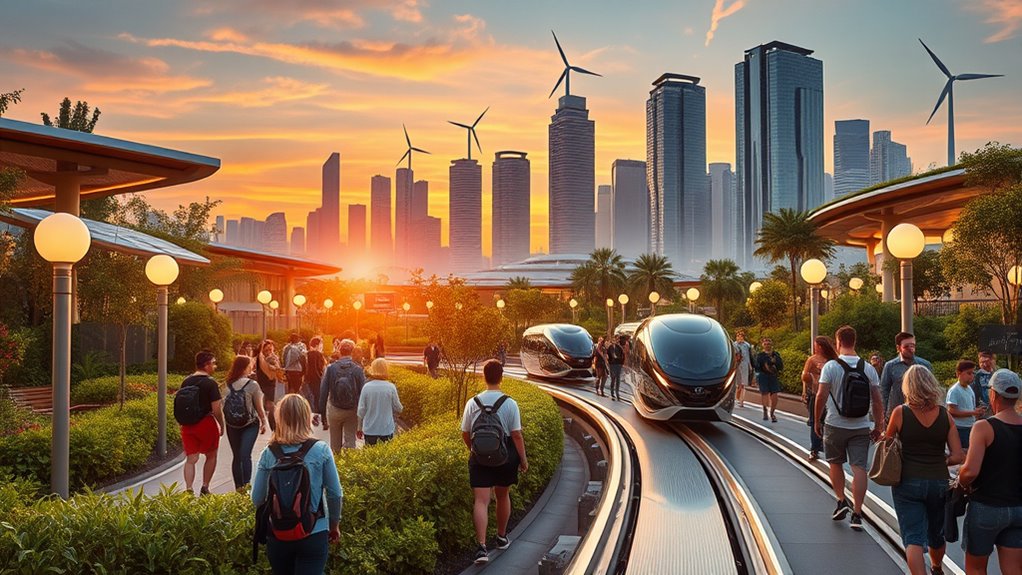
Innovative technologies are transforming sustainable travel by empowering travelers and industry stakeholders to reduce environmental impacts effectively. AI innovations optimize route planning and transport choices, helping you lower your carbon footprint. Airlines use machine learning to forecast flight demand, reducing unnecessary fuel consumption, while biometric boarding speeds up airport processes, cutting energy use. Platforms recommend eco-friendly accommodations and activities, guiding you toward greener choices. Renewable fuels like biofuels and green hydrogen further reduce emissions in cruise ships and shipping. You can now rent electric vehicles and track your travel emissions through integrated tools. These advancements make sustainable travel more accessible and efficient, ensuring your trips leave a positive environmental footprint. Incorporating smart technology into travel planning enhances the ability to monitor and minimize individual and collective carbon footprints.
Community-Based Tourism: Empowering Local Populations
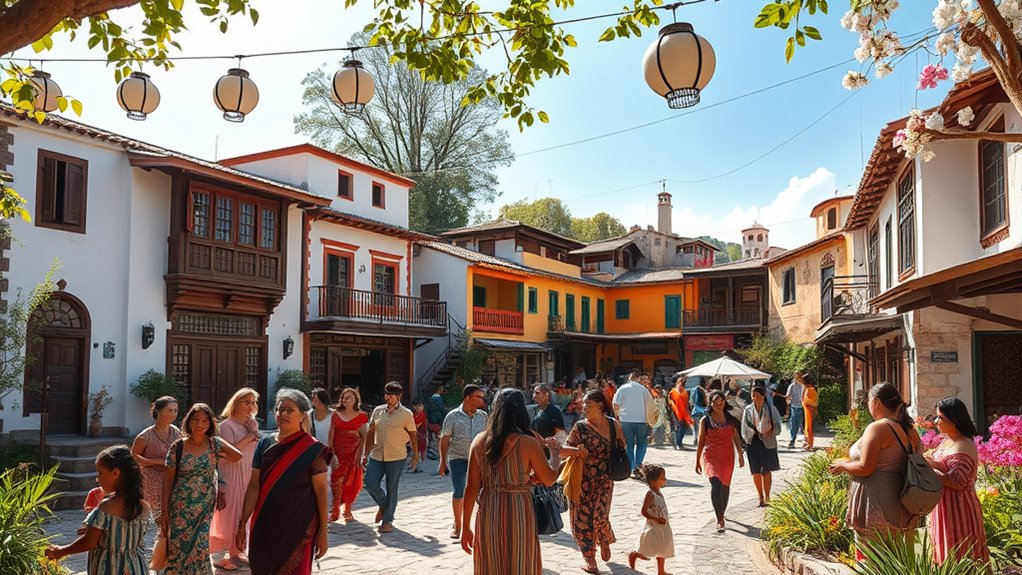
Community-based tourism (CBT) offers a powerful way to enhance sustainable travel by putting control directly into the hands of residents. This approach fosters community empowerment and encourages cultural preservation. By participating in CBT, you help guarantee that:
- 100% of financial benefits go directly to local residents, boosting economic empowerment.
- Local communities manage tourism activities, supporting traditional crafts and customs.
- Cultural heritage and natural assets are preserved through community stewardship.
- Eco-friendly practices are prioritized, protecting ecosystems and resources.
- Implementing security measures in tourism operations can safeguard sensitive data and foster trust among visitors and locals alike.
Your involvement in CBT promotes genuine cultural exchange, strengthening local identities and resilience. It creates opportunities for social inclusion, especially for women, and ensures that tourism benefits are reinvested into community development. This model aligns tourism with community needs and sustainable growth.
Policy and Investment Strategies for a Greener Future in Tourism

You can play a key role in promoting green infrastructure funding and incentives for sustainable practices in tourism. By supporting policies that prioritize eco-friendly projects and rewarding businesses that adopt responsible operations, you help build a more sustainable future. Together, these strategies will drive innovation and reduce tourism’s environmental impact worldwide. Emphasizing active listening and empathy in communication can further foster understanding and collaboration among stakeholders involved in sustainable tourism initiatives.
Green Infrastructure Funding
Green infrastructure funding in tourism relies on diverse sources and mechanisms that promote sustainable development. You can tap into green funding through programs like the EU’s Transition Pathway for Tourism, which supports eco-friendly projects. Public-private partnerships (PPPs) are key, combining government incentives with private sector investment for renewable energy and sustainable transport. Destination management organizations, such as Wonderful Copenhagen, demonstrate innovative funding models by rewarding sustainable behaviors. Additionally, carbon offset programs channel funds from travel emissions into environmental projects. Some countries, like Bhutan, implement sustainable development fees that directly support conservation and infrastructure. Your focus should be on:
- Accessing EU green funding opportunities
- Developing PPPs for infrastructure investment
- Leveraging carbon offset programs
- Utilizing tourism fees for sustainable projects
- Incorporating ethical hacking techniques to safeguard funding platforms and ensure transparency.
Incentivizing Sustainable Practices
To promote a greener future in tourism, policymakers are increasingly implementing incentives that encourage sustainable practices across the industry. These include eco labeling programs that certify eco-friendly businesses and carbon offset initiatives that help travelers compensate for emissions. You’ll see low-carbon travel packages and off-peak travel promoted to reduce environmental pressure. Support for eco-friendly accommodations and sustainable maritime operations also boosts responsible tourism. Public-private partnerships and innovative financing prioritize green projects, fostering resilience and community benefits. Certification schemes based on global standards ensure accountability, while digital tools track impacts and help refine policies. By aligning incentives with sustainability goals, you actively contribute to a tourism sector that balances growth with environmental and social responsibility. For instance, integrating preppy dog names into promotional campaigns can enhance branding by appealing to a sophisticated audience.
How Travelers Can Make a Positive Difference in the Industry

Travelers hold significant power to shape the future of the tourism industry through their choices and behaviors. By prioritizing eco-friendly accommodations and adopting responsible travel behaviors, you can make a real difference. Here are four key actions you can take:
- Choose certified sustainable accommodations, which are often cheaper and reduce your environmental impact.
- Support local communities by engaging in authentic experiences and avoiding mass tourism.
- Reduce your energy consumption during trips by using low-impact transport and conserving resources.
- Stay informed about sustainable travel options and advocate for responsible tourism practices.
Your decisions influence industry standards and encourage providers to prioritize sustainability. Every mindful choice helps create a more inclusive, environmentally responsible, and resilient tourism sector for future generations. Incorporating hydrocolloid technology in skincare exemplifies how innovative solutions can promote faster healing and better skin health, similar to how sustainable practices can foster a healthier planet.
Frequently Asked Questions
How Can Travelers Personally Support Sustainable Tourism Practices?
You can personally support sustainable tourism by making eco-conscious choices and following responsible travel tips. Opt for eco-friendly accommodations, stay on designated trails, and minimize waste by using reusable items. Support local communities by buying local goods and dining at traditional restaurants. Use public transportation or walk to reduce your carbon footprint. Sharing your experiences and advocating for responsible tourism also encourages others to follow sustainable practices.
What Are Some Examples of Eco-Friendly Travel Innovations in 2025?
In 2025, eco-friendly travel innovations include staying at eco lodges that prioritize sustainability and community welfare. You can also choose solar-powered vehicles for transportation, reducing your carbon footprint. These options help minimize environmental impact while enhancing your experience. By opting for eco lodges and solar-powered vehicles, you support sustainable tourism practices and contribute to preserving natural destinations for future travelers.
How Do Cultural Heritage Sites Benefit From Sustainable Tourism?
Sustainable tourism benefits cultural heritage sites by promoting heritage preservation and fostering cultural appreciation. You help guarantee sites are maintained through visitor spending, supporting ongoing restoration efforts. Responsible tourism encourages respect for local traditions and authentic experiences, preventing over-tourism and site degradation. By engaging with local communities, you contribute to safeguarding intangible cultural heritage, ensuring future generations can appreciate and learn from these cultural treasures while minimizing environmental impact.
What Policies Are Most Effective in Promoting Responsible Travel Globally?
Like a compass guiding travelers, effective policy frameworks shape responsible travel worldwide. You’ll find that international agreements, such as climate accords and conservation treaties, set essential standards. These policies promote sustainable practices, regulate emissions, and encourage eco-friendly tourism. When governments collaborate and enforce these agreements, responsible travel becomes a shared goal, ensuring tourism benefits local communities, protects natural resources, and reduces environmental impacts for a healthier planet.
How Can Local Communities Be Involved in Sustainable Tourism Development?
You can promote sustainable tourism by fostering community engagement and empowering locals to participate in decision-making processes. Involve them in planning, partnerships, and policy creation to guarantee their values and traditions are respected. Support local entrepreneurship and ownership of tourism projects, which boosts economic benefits and preserves cultural identity. Encourage environmental responsibility through education and conservation efforts, making sure communities lead sustainable development that benefits both people and nature.
Conclusion
As you explore the world of sustainable travel, remember your choices hold power. Every small step you take can spark a larger change, shaping a greener future for generations to come. Will you embrace innovation, support local communities, or overlook the impact of your journey? The path forward is in your hands—what will you do next to guarantee travel remains a force for good? The future of tourism hinges on your next move.
